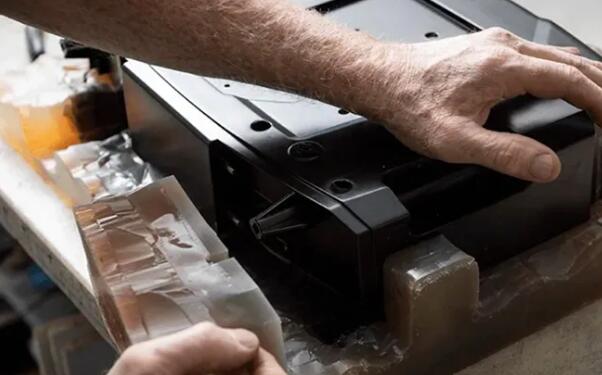Vacuum casting is a process that uses ventilated molds. The molten metal relies on air pressure to flow into the mold, and then removes the air to form a vacuum. This casting method is mainly used for small parts or jewelry with delicate details.
Vacuum molding is a kind of physical molding method. It combines vacuum technology with sand mold casting. It relies on plastic film to seal the mold hole surface and back of the sand mold, and uses a vacuum pump to pump air to produce a negative pressure, which causes the sand mold to be tightened and formed by the differential pressure inside and outside the sand mold. After the sand core is placed,After closing the mold and casting, wait for the casting to solidify, release the negative pressure or stop pumping, and the mold sand will collapse and the casting will be obtained. According to the current application field, it can be divided into vacuum sealing molding (V method) and solid vacuum casting (FV method).
Vacuum casting can be roughly divided into three types: vacuum suction casting, vacuum low pressure casting, and vacuum differential pressure casting.:
1. Vacuum suction casting
Place the mold in an airtight container and extract the air in the mold, causing a certain negative pressure in the mold, causing the liquid metal to be sucked into the mold hole. When the inner runner of the casting solidifies, the negative pressure is removed, so that the liquid metal that has not solidified in the vertical runner flows back into the bath. The advantage is that the filling capacity of the alloy liquid is improved, and the minimum wall thickness of the suction casting casting can reach O. 2mm, while the casting area is 300mm2, while reducing pores, slag and other defects. It is suitable for the production of thin and fine small precision castings, especially for cast steel (including stainless steel) parts. Its advantages are:

(1) Vacuum suction casting is conducive to the elimination of gas in the mold, suppresses turbulence and the generation of coil gas, overcomes the disadvantages of low pressure casting and differential pressure casting, and significantly improves the filling capacity of liquid metal.
(2) Due to the improvement of the filling capacity during vacuum suction casting, the casting temperature of the liquid metal can be 20 to 30℃ lower than that of gravity casting.
(3) Castings with large differences in wall thickness, thin walls and high quality requirements can be cast.
(4) By selecting the appropriate rate of change of vacuum degree and controlling the speed at which the liquid metal enters the mold hole, a stable filling effect can be obtained.
2. Vacuum and low pressure casting
The vacuum and low-pressure casting method is to vacuum the mold during the process of pressurized filling. After the filling is complete, the pressure is maintained so that the casting crystallizes and solidifies under constant pressure, and the casting is fully retracted, so that the casting has a dense structure and improved mechanical properties. This method is mostly used for precision casting of Al and Mg alloy castings. Its advantages are as follows:
(1) The presence of vacuum and negative pressure can tighten the mold sand and increase the strength of the mold.
Additional resources:(2) Moderately increase the degree of vacuum, so that the filling time is shortened, not only the filling speed is accelerated but also stable.
(3) Vacuum and low-pressure casting can speed up the fluidity of aluminum alloy at low temperatures, avoid the suction phenomenon of aluminum alloy caused by high-temperature casting, and increase the pinhole defects of castings.
(4) Castings have good formability, which is conducive to the formation of castings with clear contours and smooth surfaces and large thin-walled castings.
(5) The castings have dense tissue and high mechanical properties.
(6) Under normal circumstances, no riser is required, so that the yield of liquid metal is greatly improved, usually up to 90%.
(7) The working environment is good and the equipment is simple, which contributes to mechanization and automation.
3. Vacuum differential pressure casting
Vacuum differential pressure casting is mainly to seal all the resistance insulation furnace and the mold, and pass into the sealing cover with a larger pressure such as 500kPa of compressed air. At this time, since the mold is equal to the pressure inside the crucible, the liquid metal will not rise, and then add 50kPa pressure to the liquid metal level, the metal pressure will not rise.The liquid will rise to fill the mold hole. It is especially suitable for the production of complex thin-walled castings, but the equipment is relatively large and the operation is troublesome, and it is only used when special requirements arise. Its advantages are as follows:
(1) Compared with traditional gravity casting and vacuum suction casting, vacuum differential pressure casting has a good filling ability on thin samples with a thickness of 1mm.
(2) The castings have a denser crystalline structure and mechanical properties. In terms of the strength and properties of the castings, they are about 20% to 25% higher than vacuum suction casting and gravity casting, and the elongation is about 50% higher.
(3) Vacuum die casting can effectively reduce the pores of die castings and increase the density of castings by more than 1%.
Previous: Top Sany Bucket Teeth & Adapters: Key Benefits Explained!
Next: Discussion on the causes of frequent problems in injection molds
Related Articles
Comments
Please Join Us to post.
0